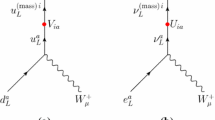Abstract
A model of weak interaction is introduced which shows maximal CP violation. The model contains an octet (or nonet) of intermediate vector meson fields with a strong tri-linear self-coupling. First order terms are forbidden, while second order terms give CP=1, third order terms CP=−1 effects. The smallness of CP-violating effects is thus easily explained.
Резюме
Разрабатывается модель слабых взаимодействий, обнаруживающая максимальное CP нарушение. Модель содержит один октет (или нонет) промежуточных векторных мезонных полей с сильной трехлинейной самосвязью. Члены первого порядка запрещены, в то время как члены второго порядка дают эффекты CP=1, а члены третьего порядка −CP=−1. Малость эффектов CP нарушения так легко обБяснена.
Similar content being viewed by others
References
Recently several interesting models of this category have been proposed, e.g.R. J. Oakes, Phys. Rev. Lett.,20, 1539, 1968;T. Das, Phys. Rev. Lett.,21, 409, 1968.
E.g.S. L. Glaschow, Phys. Rev. Lett.,14, 35, 1965;B. D’Espagna andM. K. Gaillard, in “Proceedings of the Second Coral-Gables Conference on Symmetry Principles in the High Energy”, Freeman and Company, San Francisco, 1965.
T. D. Lee, Phys. Rev.,140, B 959, 1965;S. Pakvasa, S. F. Tuan andT. T. Wu, Phys. Rev. Lett.,20, 1546, 1968;Z. Yu Kobasarev andL. B. Okun, Phys. Lett.,27B 172, 1968.
L. Wolfenstein, Phys. Rev. Lett.,13, 562, 1964.
K. Nishijima, University of Tokyo, preprint, 1967.
S. Okubo, Nuovo Cimento,54A, 491, 1968 and Annal of Physics,49, 219, 1968.
C. Fronsdal, preprint, 1968.
A possible scheme based upon this idea will be given elsewhere;S. Okubo, Nuovo Cimento,57A, 794, 1968.
This fact can be proved in a similar manner stated in a paper byS. Okubo andN. Mukunda, Annals of Physics,36, 311, 1966; Also seeT. D. Lee andG. C. Wick, Phys. Rev.,148, 1385, 1966.
An analysis of these processes has been studied in detail byA. Pais andS. B. Treiman, Phys. Rev.,176, 1974, 1968.
R. N. Mohapatra, private communication, 1968.
Author information
Authors and Affiliations
Additional information
Work supported in part by the U.S. Atomic Energy Commission.
Rights and permissions
About this article
Cite this article
Okubo, S. A model of maximal CP violation. Acta Physica 26, 205–215 (1969). https://doi.org/10.1007/BF03156823
Issue Date:
DOI: https://doi.org/10.1007/BF03156823



